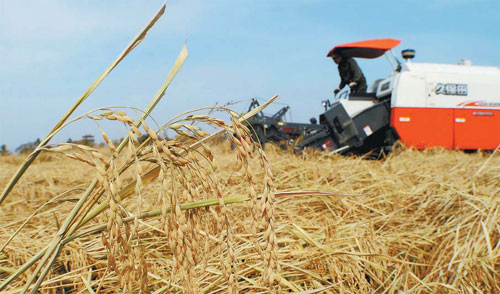Heilongjiang adapts to new normal
Province seeks new growth engines amid global slowdown, oilfield production cuts
Northeast China's Heilongjiang province is seeking new sources for growth to adapt to the economic new normal, which means slower but more sustainable growth, said a top official of the province.
Lu Hao, governor of the province, said the national strategy of revitalizing the old industrial base in Northeast China has taken effect in the province despite the dual challenges of the national economic slowdown and the petroleum production cut in the province's Daqing Oilfield.
Lu was responding to media attention on the sluggish growth in Northeast China.
The province would commercialize its industries, seize opportunities generated by e-commerce and promote industrial restructuring through reform of State-owned enterprises during the 13th Five-Year Plan (2016-20), Lu said.
Agricultural development
Heilongjiang, one of the major grain-producing areas in China, ensures food security for the country, Lu said.
The grain output of the province reached 67.6 billion kilograms in 2014, leading the country's provinces since 2011 and accounting for one-tenth of the national total, according to a government work report delivered by Lu in January.
In recent years, the province has pushed forward agricultural modernization, promoted the green food industry and established marketing platforms for Internet Plus agriculture, said Gu Yan, an official with the Heilongjiang agricultural commission.
Lu said Heilongjiang should focus on marketing agricultural products so that high sales will encourage farmers to grow organic produce. Such a move would also increase farmers' incomes and accelerate the development of the industry, he said.
A sophisticated Internet Plus marketing platform has been established for rice products in the province. Heilongjiang rice is of high quality but used to sell poorly, said Lu Xinxian, president of Harbin Zhongmi Technology Inc and dami.cn.
"We should protect the well-known brands such as Wuchang Rice and turn to e-commerce marketing channels in addition to the brick-and-mortar stores to ensure good sales," he said.
Wang Jinghai, president of Wandashan, a dairy company based in Harbin, the capital of the province, said Heilongjiang is ideal for raising cows and producing dairy.
The company is expected to sell products worth 50 million yuan ($7.8 million) this year through e-commerce channels and has set a sales goal of 300 million yuan next year, he said.
Booming tourism
Heilongjiang has also made progress in promoting the service industry's development in recent years.
The province's tourism industry experienced rapid growth through better marketing of diversified products, including ecological tourism in the summer, tourism for the elderly and snow-themed tourism in the winter, said Yu Xuesheng, director of the general office at the Heilongjiang provincial Development and Reform Commission.
The Yabuli ski resort in Shangzhi used to be administered by three government bureaus but has been overseen by one management committee since last year. It also built 10 new ski runs, installed two cable cars and increased its annual income by 40 percent in 2014 from a year earlier.
In the first three quarters of 2015, the province hosted more than 88.16 million tourists, an increase of 22.3 percent from the same period a year earlier. Its tourism revenue reached 100.7 billion yuan, up 35.58 percent year-on-year.
Energy restructuring
The energy industry, which contributed to more than half of the province's growth over the past decade, is dragging down its overall development, Lu said. It will take some time to solve the issue, which has historical reasons, he added.
Due to diminished resources and a slump in international oil prices, the Daqing Oilfield will continue to cut oil production in a scientific manner to alleviate the influence on the province's industrial growth during the 13th Five-Year Plan, said an official at the Industry and Information Technology Commission in Daqing, where the oilfield is based.
Similar issues are also plaguing the Heilongjiang Longmay Mining Holding Group, a leading coal enterprise in the province. The company has harvested more than 3 billion metric tons of coal and made a significant contribution to the country's economic development.
However, it has suffered increasing losses since 2012 because of oversupply in the market and dropping prices.
The group will solve the problem by laying off unnecessary workers and closing its departments with social functions, said Qiao Shucheng, the deputy chief engineer of the company. From 2003 to August, it laid off 30,000 employees and plans to relocate another 50,000 in the next two to three years, Qiao said.
The government and local enterprises have provided more than 70,000 jobs for the laid-off workers. The company has also established a training center for employees who want to start their own businesses.
Contact the writers through tianxuefei@chinadaily.com.cn

|
Heilongjiang, one of the major grain-producing areas in China, plans to commercialize its industries, seize opportunities generated by e-commerce and promote industrial restructuring through the reform of State-owned enterprises during the 13th Five-Year Plan (2016-20). Zhang Chunxiang / Xinhua |
|
Organic produce is on display at the Heilongjiang International Green Organic Food Industry Expo in September. Wang Kai / Xinhua |
(China Daily 12/10/2015 page10)










